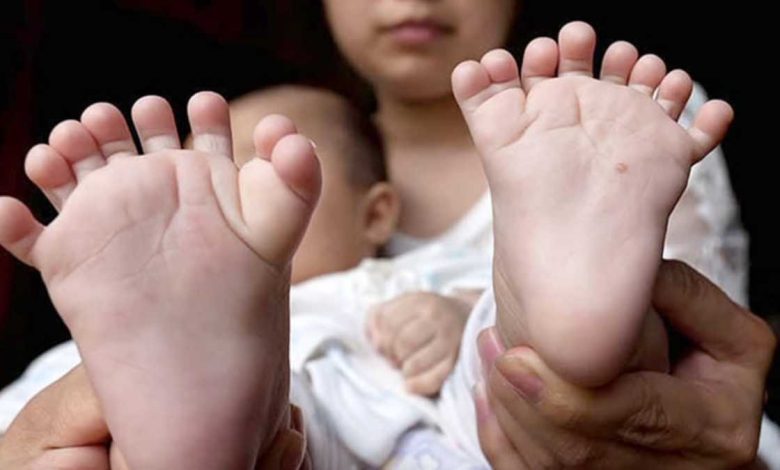Polydactyly (extra fingers or toes): What's it, causes, symptoms, diagnostics, treatment, prevention

Polydactyly; Extra digits; Supernumerary digits
What is polydactyly?
Polydactyly is a rare congenital disorder., in which a person has more, than usual, number of fingers and/or toes. More common on the hands, but can also occur on the legs. Usually, man, born with polydactyly, has six or more fingers and/or toes. The accessory fingers are often smaller in size and shape and may not be fully developed..
Extra fingers or toes (6 and more) can grow on their own. There may be no other symptoms or diseases. Polydactyly can be inherited. This trait contains only one gene., which can cause several variations.
Polydactyly can also occur in some genetic disorders..
Additional toes may be poorly developed and attached with a small foot. Most often it occurs on the little fingers of the hand.. Poorly formed fingers are usually removed. Simply tying the stem with a tight thread can lead to, that it will fall off in time, if there are no bones in the finger.
In some cases, the extra fingers may be properly shaped and even functional..
Surgery may be required to remove extra large fingers.
Causes of polydactyly
It's not always clear, why does someone have polydactyly. It is believed, that it is caused by the presence of extra DNA. Maybe, it is inherited, since about 25% people with this disease have a family member with the same disease. It may also be present as part of another genetic disorder..
Reasons may include:
- Asphyxic thoracic dystrophy
- Carpenter Syndrome
- Ellis-van Creveld syndrome (chondroectodermal dysplasia)
- Familial polydactyly
- Lawrence-Moon-Beadle Syndrome
- Rubinstein-Taibi Syndrome
- Smith-Lemli-Opitz syndrome
- Trysomyya 13
Symptoms of polydactyly
The main symptom of polydactyly is the presence of more, than usual, number of fingers and toes. It is usually noticeable at birth., but may not be noticed, until the man gets older. Extra fingers are usually smaller, than ordinary fingers. Additional fingers may not be fully developed and may be webbed, round or not too different from other fingers.
When to see a doctor
It is important to see a doctor, if you see signs or symptoms of polydactyly or if you have a family history of the condition. A doctor can confirm the condition and help you understand any risks or complications, Associated.
Questions, that your doctor may ask
When you visit the doctor for the first time, to discuss possible polydactyly, your doctor may ask some of the following questions:
- When you notice extra fingers and toes?
- Do you have other diseases?
- Are there other family members with similar conditions??
- Have you had any tests to confirm the diagnosis?
- Do you have any questions or concerns about the condition?
Diagnosis of polydactyly
Polydactyly is usually diagnosed at birth or shortly thereafter.. In some cases, extra fingers are noticed later in life.. The doctor may examine the child and ask questions about the family's medical history. The doctor may then order certain tests. Tests, used to diagnose the condition:
- Chromosomal studies
- Enzyme tests
- Roentgen
- Metabolic Research
Additional fingers may be detected at first 3 months of pregnancy with an ultrasound or a more complex test, called embryofetoscopy.
Treatment of polydactyly
Treatment for polydactyly usually involves removing extra fingers. It can be done surgically, cutting off or removing an extra finger. This procedure is usually carried out, when the baby is a few months old, but it can be done at a later age. The doctor will discuss the risks and benefits of the procedure with the parents.
Home treatment for polydactyly
There are steps you can take at home, to cope with polydactyly. If extra fingers hurt or get in the way, you can apply ice or splint, to reduce discomfort. You may also be advised to keep extra fingers clean., to reduce the risk of infection.
Prevention of polydactyly
Polydactyly is a congenital disorder, i.e. present from birth. Therefore, there is no known way to prevent it.. Nonetheless, early detection and treatment can help manage the condition. If you have a family history of polydactyly, you should talk to your doctor about any concerns and get regular medical checkups, to monitor any signs or symptoms.
Used sources and literature
Carrigan RB. The upper limb. In: Kliegman RM, St. Geme JW, Bloom NJ, Shah SS, Tasker RC, Wilson KM, eds. Nelson Textbook of Pediatrics. 21st ed. Philadelphia, PA: Elsevier; 2020:chap 701.
Mauck BM. Congenital anomalies of the hand. In: Azar FM, Beaty JH, eds. Campbell’s Operative Orthopaedics. 14th ed. Philadelphia, PA: Elsevier; 2021:chap 80.
Son-Hing JP, Thompson GH. Congenital abnormalities of the upper and lower extremities and spine. In: Martin RJ, Fanaroff AA, Walsh MC, eds. Fanaroff and Martin’s Neonatal-Perinatal Medicine. 11th ed. Philadelphia, PA: Elsevier; 2020:chap 99.
